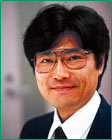Clarifying the Mechanism of Gene Manifestation
Gene regulation plays a critical role in a living organism's functional morphology. In this context, the research unit led by Dr. Takashi Kondo is investigating the mechanisms that determine how particular genes are selected to express in right place and right time from large DNA molecules called chromosomes.
Dr. Kondo went to work for a chemical company following the completion of his master's, where he was involved in genetic research on tryptophan and an enzyme used in detergents. After two years of research, he returned to graduate school to continue his studies.
“I had wanted to pursue research on the biological development of higher-level animals since my days as an undergraduate. For, while the form of human beings may seem to be strictly determined by heredity, there are both speciesspecific characteristics and characteristics that are common to many species. I was very interested in how the shapes of living things are determined. It was this interest that led to my current research.”
Around the time that Dr. Kondo returned to graduate school, the homeotic genes* that determine the development of the anterior-posterior specificity of body segments in the Drosophila (fruit fly) were discovered. Because this subject remained unclear for mammals, Dr. Kondo decided to dig deeper into our understanding the mammalian homeobox**.
“Actually, I left the chemical company and returned to research after working in the laboratory of Dr. Yoshiyuki Sakaki. At the time he was a professor at Kyushu University and is the current director of the RIKEN Genomic Science Center. One day, Prof. Sakaki called me over and asked, ‘Wouldn't you like to return to research work?’ Having such a proposal from Dr. Sakaki was a great opportunity for me.”
A Free Research Environment
Dr. Kondo's post-graduate research experience was unusual because he was the only one conducting homeobox research in the laboratory.
“An assistant who was researching the same subject left soon after I arrived, but Prof. Masami Muramatsu (the director of the Saitama Medical School Research Center for Genomic Medicine) was a patient and generous person. He is simply told me to find a new research topic. At that time, his laboratory focused its efforts on steroid receptors, which are steroid-sensing transcription factors. These receptors had not yet been located in the fruit-fly even though they were thought to play an important role in the metamorphosis function. When I told Prof. Muramatsu that I would like to conduct research on the Drosophila receptor, he expressed immediate interest. However, three days later, he laughingly said, ‘No, we should not be dealing with insects. Since we are working in the Medical School, our subjects should have vertebrae (laughter).’ We decided that I should continue my research on the homeobox alone.”
The free atmosphere that Dr. Muramatsu created in his laboratory may be one of the reasons why his laboratory has produced so many famous researchers.
According to Dr. Kondo, he experienced a similar atmosphere at the University of Geneva, where he conducted postdoctorate research from 1994 to 2000. “All of the laboratory staff was housed on the fourth floor, except for my own small laboratory. This was located on the third floor, and in this private environment I was able to pursue my research undisturbed.”
Flexible Research
While in Geneva, Dr. Kondo applied for a position at BSI recruit in response to an Internet advertisement. After six years overseas, this brought him back to Japan.
“Actually I had decided that I would go to an institute in the USA. However, my personality is such that I tend to take a relatively long time to draw final conclusions about my results. Therefore, I felt that I might not be suited to the American research system where researchers produce many research papers in a short period of time. In Europe, research may still be evaluated as significant even if it is presented only after several years of work. I found that my professors at the graduate school and in Geneva were excellent with regard to this point. When I proposed a topic that I wanted to research, they all took the approach that I should be encouraged to spend sufficient time on it to make sure the work was completed satisfactorily.”
However, after returning to Japan, Dr. Kondo feels that the Japanese research system, particularly its grant system, is beginning to resemble that of the USA. He sometimes even feels that the Japanese “emphasis on applications” has already exceeded that of the USA.
“Perhaps my orientation towards basic research in the truest sense of the concept is too strong, but I feel that no breakthrough finding will develop without new discoveries at the most fundamental levels of research. I feel that research in Japan has entered a critical state because a significant amount of university research activity overlaps with privately funded research. The fundamental core of basic research is disappearing. This said, however, the situation at RIKEN is significantly better because this organization retains control over its own budget.”
Researching in free and unrestricted environments and benefiting from many unexpected opportunities, Dr. Kondo has developed a clear idea about what research is. “First and foremost, it is important to have a deep conviction about a topic. With this in place, the actual form of research automatically follows. The importance of dealing flexibly with events as they occur is also something I try to remember.” These are principles that shape how he manages his research unit, too. Dr. Kondo formulates suitable topics for individual researchers, but he also listens carefully to each of their research ideas. The researchers are thus empowered to tackle their projects with optimum flexibility.






